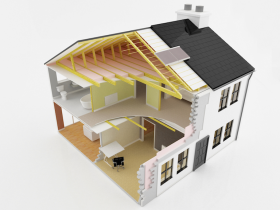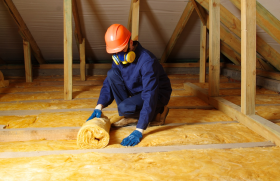As we continue through the winter months, and prepare for the ever-changing climate, rising oil and wholesale gas prices, insulation has never been more important. But how can consumers achieve a well-insulated home that reduces their energy bills and the planet? Henry Martin, thought leader and residential and commercial developer, discusses why good insulation is important and how this can be achieved in homes.

Insulation doesn’t just add extra warmth to your home, it also benefits the environment. By reducing the amount of heating you need to use, you reduce the impact you have on the environment through less pollution, less gas burnt, and less carbon dioxide released into the atmosphere.
As well as providing benefit to the environment, insulation retains the heat your home produces, making it more efficient to run.
Identifying Insulation Gaps
When beginning to improve your insulation, it’s important to not only apply measures holistically, but to first look at gaps in your homes insulation that will make savings first.

To identify insulation gaps in buildings, a thermal imaging survey can be an easy way to identify areas of heat loss across the building. It’s best to do these either in the morning or evening, when the heating is on, as this can then pick up immediate loss and find gaps.
As insulation is often applied retrospectively, your building may not be fully optimised for heat loss, especially if it is not a new build.
How to Improve Insulation
Once you have identified insulation gaps in your homes, it is a good idea to speak to a government assessor or provider, as they can help you to decide which insulation measures for your home. They’re independent providers, and look at multiple factors, including a holistic view of your building and which measures would provide the most benefit to install first, and give you the most savings.
Some common measures they may suggest include:
- Floor insulation
- Cavity wall insulation
- Replace windows
- Add loft insulation
- Upgrade your external doors
Floor insulation
Floor insulation can either be for solid or suspended floors.
Solid floor insulation
For homes built with a concrete foundation or a solid floor, additional insulation can either be added below the foundation by drilling down and inserting a damp proof membrane, or by applying a thin layer of insulation between the existing floors and the foundations of the home.
This helps to not only prevent rising damp, but will keep heat in. However, it is a large and very disruptive piece of work.
Suspended floor insulation
For floors that have an air gap, or a space between the floor and the foundation, such as those built on timber frames, insulation can easily be added through an injection or by accessing the joists when other work such as flooring, or carpeting is being done.
New build homes are now required to be built with under floor insulation, but for homes built after 1995, it can be an easy and effective way to improve home insulation, while not making major reconstruction changes to the home.
Cavity wall insulation
Although a contentious subject in the past, cavity wall insulation is now highly regulated, and can be immediately effective.
In the air gap between outer walls and inner walls, there is often a cavity, or air gap. This was increasingly common in homes built between 1920 and the 2000s, and as such, many homes built then will not have any existing cavity wall insulation.
To install cavity wall insulation, someone will either use mineral wool or foam, and inject it into the cavity.
You can get grants to help with the cost of cavity wall insulation, and it is installed by a professional installer.
Replace windows
For those with older homes, or older insulation, there is often a lot of savings to be made with new, energy efficient windows. Windows are now rated with EPCs (Energy Performance Certificates) to show how efficient they are.
If your windows feel draughty, or regularly condense up, then you may want to consider replacing some, or all of your windows.
Design doesn’t have to be compromised either, metal framed windows are becoming a popular choice, and suit all homes, including older ones where PVC may look out of place or threaten the heritage status of a place.
Add loft insulation

Loft insulation is often an easy way to trap heat in, especially if you’ve already applied other heat saving measures. You can either replace existing loft insulation or add more to what you already have.
If you have less than 270mm thick loft insulation, it’s recommended you add some more to trap heat in. As heat rises, by insulating your loft, you can easily stop heat escaping and keep upstairs rooms warm.
For pitched roofs, you can apply it with boards to the pitch, and add rolls to the flat floor. This can be a DIY job, or a professional installer may be able to help.
Upgrade your external doors
External doors are often where heat is lost. As these are slim defences against outside weather, they often take a beating. For homes with porches or lean-to’s, some defence is offered, but for many buildings, there is none.
Therefore, any easy way to insulate and prevent heat escaping is to replace and upgrade doors. Technology and door designs have improved tenfold, and now wood imitation doors made from PVC are much more common, and look stylish, while maintaining an aspect of weathertightness.